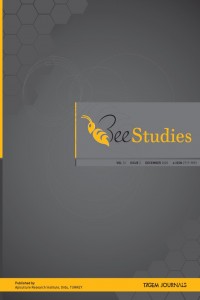Abstract
References
- Anonim a, (2020). Arıcılık İstatistikleri. Retrieved from https://arastirma.tarimorman.gov.tr/aricilik/Link/2/AricilikIstatistikleri. Turkey Apiculture Statistics for Production of Honey in 2019.
- Anonim b, (2020). Retrieved from https://www.tarimorman.gov.tr/HAYGEM/Belgeler/Hayvancılık/Küçük Evcil Yetiştiriciliği/Arıcılık/2020 YILI/Ana Arı Üretim İzinli İşletmeler.xls
- Akyol, E., Yeninar, H., & Kaftanoglu, O. (2008). Live weight of queen honey bees (Apis mellifera L.) predicts reproductive characteristics. Journal of the Kansas Entomological Society, 81(2), 92-100.
- Arslan, S., Arslan, H. S., Cengiz, M. M., & Karakuş, B.(2018). Determination of Conformity of The Quality Criteria to Queen Production Standards in The Early Period of Mediterranean Region. 6th International Mugla Beekeeping & Pine Honey Congress (pp.42-48). Muğla, Turkey.
- Colley, W. W., & Lohnes, P. R. (1971). Multivariate data analysis. Multivariate Data Analysis, New York: John Wiley & Sons.
- Karaca, Ü., & Karaman, S. (2018). Queen Production Costs and Profitability Analysis in Turkey. ANADOLU Journal Of Aegean Agricultural Research, 28(2), 17-28.
- Little, T. M., & Hills, F. J. (1978). Agricultural Experimentation. New York: John Wiley & Sons.
- Mackensen, O., & Tucker, K. W. (1970). Instrumental insemination of queen bees. Agriculture Handbook, No:390; Washington. pp. 1-28.
- Uzun, M. Y. (2020). The Effect of Different Feeding Diets on Queen Bee Quality Parameters (MSc Thesis). Mustafa Kemal University, Hatay, Turkey.
- Yeninar, H., Akyol, E., & Yörük, A. (2007). Investigation of body weight changes in mated queens produced in queen bee-producing companies. III. Marmara Beekeeping Congress (pp.25). Bursa, Turkey.
Effect of Number of Worker Bees in Queen Mating Nucleus on Queen Quality and Mating Nucleus Population Dynamics
Abstract
This study aims to investigate the effects of the amount of worker bees placed into the mating nucleus on queen quality parameters and nucleus population dynamics. The quantity of 80(g) (~700 workers) that mating nucleus made of Kirchhain-model can contain has been based on. A total of 24 mating hives, including 8 in each group containing 80, 160 and 320 grams worker bees increasing at a geometric progression, were used in the study. Each mating nuclei been used in queen production for 3 times (20 day interval) without any addition of worker bees, depending on the climate and vegetation conditions during the production period. In groups containing 80,160 and 320 gram workerbees, spermatheca diameters (mm) 1.14±0.19, 1.11±0.13 and 1.16±0.09, sperm counts stored in spermatheca 3268859±288.830, 4217444±182468 and 4875752±304443, live weights of the laying queen (mg) 188.5±2.55, 205.8±4.09 and 229.6±4.34, worker bee weights (g) in mating nuclei after research were 100.85±4.39, 223.85±14.44 and 413.66±43.84 found to be respectively. At the end of the study conducted in Hatay Province between April 25 - June 25 2019, overall increase in the worker bee population was observed average to be 31.87±5.39%. The population increase in 80, 160 and 320 g of live worker bee groups were observed to be 26.07±5.47, 39.91±9.02 and 29.27±13.70% respectively. After 60 days & 3 periods of queen breeding the differences between groups were found to be statistically insignificant (P>0.05). The differences between the groups, the sperm counts, laying queen weight and amount of worker bees were found to be statistically significant (P<0.01).
Keywords
References
- Anonim a, (2020). Arıcılık İstatistikleri. Retrieved from https://arastirma.tarimorman.gov.tr/aricilik/Link/2/AricilikIstatistikleri. Turkey Apiculture Statistics for Production of Honey in 2019.
- Anonim b, (2020). Retrieved from https://www.tarimorman.gov.tr/HAYGEM/Belgeler/Hayvancılık/Küçük Evcil Yetiştiriciliği/Arıcılık/2020 YILI/Ana Arı Üretim İzinli İşletmeler.xls
- Akyol, E., Yeninar, H., & Kaftanoglu, O. (2008). Live weight of queen honey bees (Apis mellifera L.) predicts reproductive characteristics. Journal of the Kansas Entomological Society, 81(2), 92-100.
- Arslan, S., Arslan, H. S., Cengiz, M. M., & Karakuş, B.(2018). Determination of Conformity of The Quality Criteria to Queen Production Standards in The Early Period of Mediterranean Region. 6th International Mugla Beekeeping & Pine Honey Congress (pp.42-48). Muğla, Turkey.
- Colley, W. W., & Lohnes, P. R. (1971). Multivariate data analysis. Multivariate Data Analysis, New York: John Wiley & Sons.
- Karaca, Ü., & Karaman, S. (2018). Queen Production Costs and Profitability Analysis in Turkey. ANADOLU Journal Of Aegean Agricultural Research, 28(2), 17-28.
- Little, T. M., & Hills, F. J. (1978). Agricultural Experimentation. New York: John Wiley & Sons.
- Mackensen, O., & Tucker, K. W. (1970). Instrumental insemination of queen bees. Agriculture Handbook, No:390; Washington. pp. 1-28.
- Uzun, M. Y. (2020). The Effect of Different Feeding Diets on Queen Bee Quality Parameters (MSc Thesis). Mustafa Kemal University, Hatay, Turkey.
- Yeninar, H., Akyol, E., & Yörük, A. (2007). Investigation of body weight changes in mated queens produced in queen bee-producing companies. III. Marmara Beekeeping Congress (pp.25). Bursa, Turkey.
Details
| Primary Language | English |
|---|---|
| Subjects | Agricultural, Veterinary and Food Sciences |
| Journal Section | Research Articles |
| Authors | |
| Publication Date | December 31, 2020 |
| Submission Date | November 24, 2020 |
| Published in Issue | Year 2020 Volume: 12 Issue: 2 |


